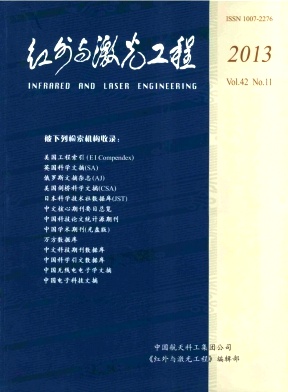Yin Kewei, Huang Zhiqiang, Lin Wumei, Xing Tingwen. Effects of design parameters of diffractive optical element on stray light[J]. Infrared and Laser Engineering, 2013, 42(11): 3059-3064.
| Citation:
|
Yin Kewei, Huang Zhiqiang, Lin Wumei, Xing Tingwen. Effects of design parameters of diffractive optical element on stray light[J]. Infrared and Laser Engineering, 2013, 42(11): 3059-3064.
|
Effects of design parameters of diffractive optical element on stray light
- 1.
Institute of Optics and Electronics,Chinese Academy of Sciences,Chengdu 610209,China;
- 2.
University of Chinese Academy of Sciences,Beijing 100049,China
- Received Date: 2013-03-10
- Rev Recd Date:
2013-04-25
- Publish Date:
2013-11-25
-
Abstract
Diffractive optical elements (DOEs) have been widely applied to acquire different beam shapes in illumination systems. However, the experimental values of diffraction efficiency are greatly different from the ideal values because of stray light of high diffractive orders around the targeted spot. The reasons were theoretically discussed for the stray light and many DOEs with different design parameters were simulated. Through the simulation analysis, a new parameter, named relative period, was defined. It was proportional to the wavelength and inversely proportional to the far-field diffraction angle and the size of DOE cells. It is suggested that the diffraction efficiency, which is independent from the beam shapes, could be improved by increasing relative period. As a result, the stray light of high diffractive orders could be suppressed effectively by regulating the parameters of the far-field diffraction angle and the size of DOE cells. The new parameter has an important role in the design of DOE.
-
References
|
[1]
|
Gerchberg R W, Saxton W O. A practical algorithm for the determination of phase from image and diffraction plan pictures[J]. Optik, 1972, 35: 237-246. |
|
[2]
|
|
|
[3]
|
|
|
[4]
|
David L Shealy. Theory of geometrical methods for design of laser beam shaping systems[C]//SPIE, 2000, 4095: 1-15. |
|
[5]
|
|
|
[6]
|
Wang Wei, Li Tao, Li Yongpin. A hybrid algorithm for the design of DOE in uniform illumination[J]. Optics Communications, 2000, 181: 261-265. (in Chinese) |
|
[7]
|
|
|
[8]
|
Zhou Jieyu, Lu Yaxiong, Wang Li, et al. An improvement on GS algorithm for design of computer optical elements[J]. Journal of Optoelectronics. Laser, 2007, 18(10): 1180-1183. (in Chinese) |
|
[9]
|
|
|
[10]
|
Li Yuanyuan, Qiu Chuankai, Li Pan, et al. Shape the unstable laser beam using diffractive optical element array[C]//SPIE, 2010, 7848: 1-9. |
|
[11]
|
|
|
[12]
|
Pang Hui, Ying Chaofu, Fan Changjiang, et al. Design diffractive optical elements for beam shaping with hybrid algorithm[J]. Acta Photonica Sinica, 2010, 39(6): 977-981. (in Chinese) |
|
[13]
|
Rong Wu. Efficient calculating and designing algorithms for diffractive optics elements[D]. Hefei: University of Science and Technology of China, 2008: 59-74. (in Chinese) |
|
[14]
|
|
|
[15]
|
|
|
[16]
|
Joseph W Goodman. Introduction to Fourier Optics[M]. Beijing: Publishing House of Electronics Industry, 2006: 20-24. |
|
[17]
|
|
|
[18]
|
Zhang Wei, Gong Yan. Vector analysis of diffractive optical elements for off-axis illumination of projection lithographic system[J]. Acta Photonica Sinica, 2011, 31(10): 1-5. (in Chinese) |
|
[19]
|
Toufic G Jabbour, Stephen M Kuebler. Vectorial beam shaping[J]. Optics Express, 2008, 16(10): 7203-7213. |
-
-
Proportional views

-









 DownLoad:
DownLoad: